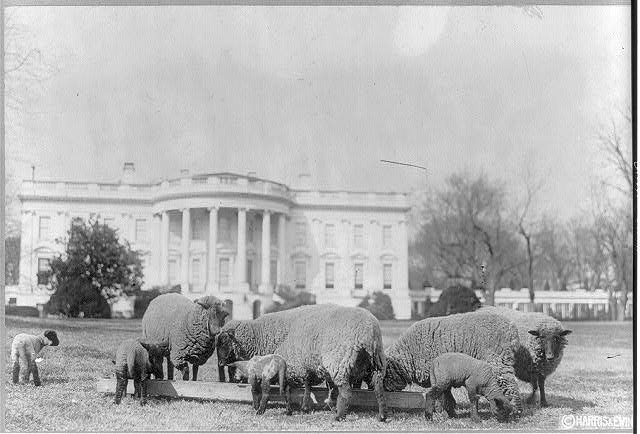Sheep and Wool

Sheep are very gentle animals and are easily frightened. They flock together for protection because they can't really protect themselves. Sheep have many natural predators, animals that hunt and kill sheep for food. They include coyotes, wolves and domestic dogs. Sometimes larger animals, like mules or llamas, are kept in the pastures with the sheep to scare off possible predators.
The people who raise and care for sheep are called shepherds. Sometimes, shepherds have dogs to help take care of the sheep. The dog learns to round up the sheep, and when one wanders from the flock, the dog brings it back.
There are many different breeds of sheep. Some are raised for meat, and others primarily for their wool. Sheep are valuable because they often graze land that other livestock cannot. Sheep eat grass and hay. Oklahoma is a good place for raising sheep because it is one of only a few states that has year-round forage production.
Sheep were some of the first animals to be domesticated by ancient people. They have been providing meat and clothing to people for over 10,000 years. Spinning wool into thread began about 5,000 years ago.
Wool is a special natural fiber. It always feels warm and soft. It is very good at keeping out the cold and at warming your skin. Even if your wool sweater gets wet from snow or rain, it will still keep you warm. Wool also wears well and lasts for a long time. One of the best things about wool fabric is that it is flame resistant, so it is safer to wear than some other fabrics.
One sheep produces eight to ten pounds of wool per year, enough to make a man's suit. One pound of wool can make ten miles of yarn.
Wool straight from the sheep is called raw wool. Raw wool may go through more than 70 processing steps to assure that fabrics made from the wool are of the highest quality.
Oklahoma's sheep and lamb inventory on January 1, 2016, was 746,000 head. Wool produced from Oklahoma sheep in 2016 was 95,000 pounds.
Wool can have a wide range of natural colors and textures, depending on which animal produced the fleece. To help consumers and spinners identify pure wool, the wool industry designed a trademark symbol. The wool symbol can only be used on products made from pure new wool. The wool symbol is used and recognized all over the world.
Wool can also be made from the hair or fur of goats, rabbits, llamas, alpaca, and even a semi-wild animal from the Andes mountains called a vicuna.
Learning Activities
- PowerPoint
- Keynote
- Smart Board Activity: Alliteration
(Need help?)Please be patient with us as we learn how to use this new technology.
You must have Smart Notebook software installed on your computer to open Smart Board activities. If you have Smart Notebook software and are using Internet Explorer, you may get a message telling you the activity cannot be opened. In this event, save the activity to your hard drive. Your browser will save it as a zip file. Simply change the "zip" in the file name to "notebook," and you should be able to open it.
Thank you for your patience.
Smart Board Acitivity page
 When Woodrow Wilson was President, the First Lady had sheep graze on the White House lawn to keep it neat and well-trimmed.
When Woodrow Wilson was President, the First Lady had sheep graze on the White House lawn to keep it neat and well-trimmed.
Additional Resources
- Books
- Crafts
- Different Kinds of Wool
- More about sheep in ancient history
- Game: Have You Seen My Sheep?
- Common Words and Phrases With Sheep Origins
- Lillie, the Lamb, and the Scary Secret — MS Word
- Lillie, the Lamb, and the Scary Secret — PowerPoint
- Sheep Breeds
- More Facts about Sheep and Wool
- Agriculture in Art
- Shepherd With a Flock of Sheep, 1884 by Vincent Van Gogh
- Sheep in a Winter Landscape by Thomas Sydney Cooper
 Shepherd With a Flock of Sheep, 1884> by Vincent Van Gogh
Shepherd With a Flock of Sheep, 1884> by Vincent Van Gogh
